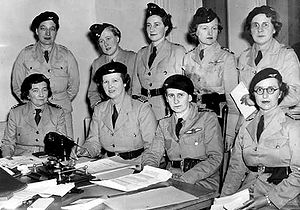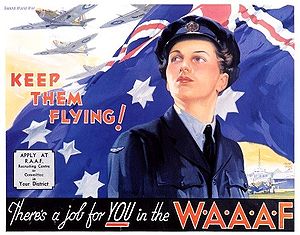- Mary Bell (aviator)
-
Mary Teston Luis Bell 
Mary Bell commanding the Women's Air Training Corps, 1941Nickname "Paddy" Born 3 December 1903
Launceston, TasmaniaDied 6 February 1979 (aged 75)
Ulverstone, TasmaniaAllegiance  Australia
AustraliaService/branch  Royal Australian Air Force
Royal Australian Air ForceYears of service 1941–1945 Rank Flight Officer Unit WAAAF (1941–1945) Battles/wars World War II Other work Farmer Mary Teston Luis Bell (3 December 1903 – 6 February 1979) was an Australian aviator and founding leader of the Women's Air Training Corps (WATC), a volunteer organisation that provided support to the Royal Australian Air Force (RAAF) during World War II. She also helped establish the Women's Auxiliary Australian Air Force (WAAAF), the first and largest women's wartime service in the country, which grew to number more than 18,000 members by 1944. Born Mary Fernandes in Tasmania, she married RAAF officer John Bell in 1923 and obtained a pilot's licence in 1927. Given temporary command of the WAAAF on its formation in 1941, she was passed over as its inaugural Director in favour of corporate executive Clare Stevenson. Bell refused the post of Deputy Director and resigned, but subsequently rejoined and served until the final months of the war. She and her husband later became farmers. Nicknamed "Paddy",[1] Mary Bell died in 1979 at the age of seventy-five.
Contents
Early life and WATC
Born on 3 December 1903 in Launceston, Tasmania, Mary Bell was the daughter of Rowland Walker Luis Fernandes, an English-born clerk, and his wife Emma. She attended Church of England Girls' Grammar School, Launceston and St Margaret's School, Devonport, before commencing work in a solicitor's office at the age of fourteen. She married John Bell (1889–1973), a Royal Australian Air Force officer and World War I veteran of Gallipoli and the Australian Flying Corps, at St Andrew's Anglican Church in Brighton, Victoria on 19 March 1923. They had one daughter.[2]
From 1925 until early 1928, the Bells lived in Britain while John attended RAF Staff College, Andover and acted as RAAF liaison officer to the Royal Air Force. Interested in aviation since her teens, Mary learnt to fly in England and in April 1927 qualified for a Grade 'A' private pilot's licence.[2][3] Returning to Australia, she was the first female to gain a pilot's licence in Victoria, on 20 March 1928. The following year, she became the first Australian woman to qualify as a ground engineer.[4]
By 1939, the Bells had moved to Brisbane, where John was Queensland manager for Airlines of Australia Ltd, having left the RAAF in 1929. Mary became leader of forty or so members of the Women's National Emergency Legion Air Wing who had volunteered to assist with aircraft maintenance during times of war. Determining that their objectives would not be met in their existing organisation, on 17 July they formed a new paramilitary group, the Women's Air Training Corps (WATC), and elected Bell its commander. She soon expanded the WATC into a national organisation, with Commandants leading each state's chapter, and herself as Australian Commandant.[1][2] Bell wrote to Air Vice Marshal Richard Williams, with whom she was acquainted via her husband and through aviation circles, advocating the establishment of a women's branch of the RAAF similar to the RAF's Women's Auxiliary Air Force (WAAF). Among other things, she pointed out that female volunteers such as hers were already supporting the Air Force in driving, nursing and clerical duties.[5] The WATC was one of a number of women's voluntary organisations whose members were keen to support the military, arguing that their personnel provided a ready-made pool of skilled staff for auxiliary services, saving the government time and money associated with training unskilled labour.[6]
World War II and WAAAF
Australia having declared war on 3 September 1939, the RAAF Air Board met in November to discuss Mary Bell's letter, but postponed taking any further action. Bell continued to lobby, however, as did various women's groups seeking to support the war effort and free male staff for overseas postings.[5][7] In July 1940, the new Chief of the Air Staff, Air Chief Marshal Sir Charles Burnett, invited her to produce a proposal for a women's auxiliary, supervised by her husband John, who had rejoined the Air Force at the war's outbreak and was now a wing commander in the Directorate of Organisation at RAAF Headquarters, Melbourne. Mary recommended forming the new service under the Air Force Act to permit women to enlist for the duration of the war under conditions similar to RAAF members, rather than enrolling on a short-term contractual basis, a radical idea at the time which would not be put in place until 1943. She also suggested a volunteer reserve or 'citizen' force to augment the enlisted women, effectively the existing WATC, though this was seen as placing too much emphasis on her personal command.[8] Various senior Air Force officers, including the recently promoted Air Marshal Williams, and the Director of Personnel Services, Group Captain Joe Hewitt, opposed a women's service. Burnett, an RAF member who appreciated how the WAAF proved its worth during the Battle of Britain, championed its establishment as the Women's Auxiliary Australian Air Force (WAAAF).[9]
I was given an office containing two tables, one chair, one form, one telephone and nothing else and told to get on with it... Luckily I had been associated with the R.A.A.F. since its formation when my husband was one of the original officers so knew most of the senior officers and my way about generally.
Mary Bell, on leading the WAAAF in 1941 [7]Bell was appointed to the RAAF's Personnel Branch as Staff Officer (Administrative) with the probationary rank of section officer (acting flight officer) on 24 February 1941, in order to "get the organisation going".[10] Formally established on 25 March, the WAAAF was the first uniformed women's branch of an armed service in Australia, predating similar organisations in the Army and Navy. Bell led the WAAAF for the first three months of its existence, recruiting approximately two hundred women by June; of the first six officers she appointed, five were former members of the WATC.[6][7] On 21 May 1941, Berlei corporate executive Clare Stevenson was appointed Director WAAAF with Bell as her Deputy Director, effective from 9 June.[11] The Air Member for Personnel, Air Vice Marshal Henry Wrigley, chose Stevenson on the basis of her management background and because she was not a "socialite".[12] Notwithstanding her aviation experience and familiarity with the RAAF, he considered Bell to be "tangled up with the WATC", where she "waved the flag and obtained a great deal of publicity for herself".[10] She may also have alienated Burnett by not including his daughter Sybil-Jean, a founding member of the WAAF, among the initial intake of staff.[13]
Bell chose to resign on learning of Stevenson's appointment, rather than stay on and report to someone from outside the service fraternity; she later rejoined at Wrigley's request, on the condition that she received no promotion higher than flight officer.[7] Two of her original officer appointees also resigned when Bell was passed over, later describing her as "a thorough and effective organiser" and the "obvious choice" as Director.[13] After Bell returned to the WAAAF on 5 October 1942, she served at RAAF Headquarters in various directorates, mainly that of Medical Services.[14] Despite her recommendation in July 1940 that they be enlisted into the WAAAF as permanent staff, women were at first enrolled only for renewable twelve-month contracts; they did not become part of the Permanent Air Force, with the benefits that entailed, until 1943. Pay was only ever two-thirds that of male equivalents. The organisation grew rapidly, however, peaking in strength at over 18,600 members in October 1944, or twelve per cent of all RAAF personnel.[12] By the end of the war a total of 27,000 women had served in the WAAAF, comprising over thirty-one per cent of ground staff and filling sixty-one trades, all previously occupied by men.[15]
Later life
Ranked flight officer, Mary Bell was discharged from the WAAAF at her own request on 11 April 1945.[14][16] Her husband John was acting air commodore when he left the RAAF on 15 October that year.[2][17] The WAAAF, first and largest of Australia's wartime women's services, was disbanded on 30 September 1946.[12][18] The Bells became farmers, first in Victoria and then in Tasmania, before retiring in 1968. Survived by her daughter, Mary Bell died in Ulverstone, Tasmania on 6 February 1979. She was buried at Mersey Vale Memorial Park cemetery in Spreyton, near Devonport, beside her husband, who had died in 1973.[2]
Notes
- ^ a b Thomson, The WAAAF in Wartime Australia, pp. 37–39
- ^ a b c d e Bell, Mary Teston Luis at Australian Dictionary of Biography. Retrieved on 18 October 2009.
- ^ Thomson, The WAAAF in Wartime Australia, p. 335
- ^ Thomson, The WAAAF in Wartime Australia, p. 27
- ^ a b Thomson, The WAAAF in Wartime Australia, p. 42
- ^ a b Hasluck, The Government and the People 1939–1941, pp. 401–408
- ^ a b c d Gillison, Royal Australian Air Force 1939–1942, pp. 99–100
- ^ Thomson, The WAAAF in Wartime Australia, pp. 52–54
- ^ Thomson, The WAAAF in Wartime Australia, pp. 68–72
- ^ a b Thomson, The WAAAF in Wartime Australia, pp. 72–77
- ^ Thomson, The WAAAF in Wartime Australia, p. 338
- ^ a b c Dennis et al., The Oxford Companion to Australian Military History, p. 606
- ^ a b Thomson, The WAAAF in Wartime Australia, pp. 92–94
- ^ a b Thomson, The WAAAF in Wartime Australia, p. 363
- ^ Stephens, The Royal Australian Air Force, pp. 155–156
- ^ Bell, Mary Teston Luis at World War W2 Nominal Roll. Retrieved on 18 October 2009.
- ^ Bell, John Renison at World War W2 Nominal Roll. Retrieved on 18 October 2009.
- ^ Stephens, The Royal Australian Air Force, pp. 203–205
References
- Dennis, Peter; Grey, Jeffrey; Morris, Ewan; Prior, Robin (2008) [1995]. The Oxford Companion to Australian Military History. South Melbourne: Oxford University Press. ISBN 9780195517842.
- Gillison, Douglas (1962). Australia in the War of 1939–1945: Series Three (Air) Volume I – Royal Australian Air Force 1939–1942. Canberra: Australian War Memorial. http://www.awm.gov.au/histories/second_world_war/volume.asp?levelID=67912.
- Hasluck, Paul (1962). Australia in the War of 1939–1945: Series Four (Civil) Volume I – The Government and the People 1939–1941. Canberra: Australian War Memorial. http://www.awm.gov.au/histories/second_world_war/volume.asp?levelID=67916.
- Stephens, Alan (2006) [2001]. The Royal Australian Air Force: A History. London: Oxford University Press. ISBN 0195555414.
- Thomson, Joyce (1991). The WAAAF in Wartime Australia. Melbourne: Melbourne University Press. ISBN 0522845258.
Categories:- 1903 births
- 1979 deaths
- Australian aviators
- Female aviators
- People from Tasmania
- Royal Australian Air Force officers
- Royal Australian Air Force personnel of World War II
- Women in the Australian military
Wikimedia Foundation. 2010.


